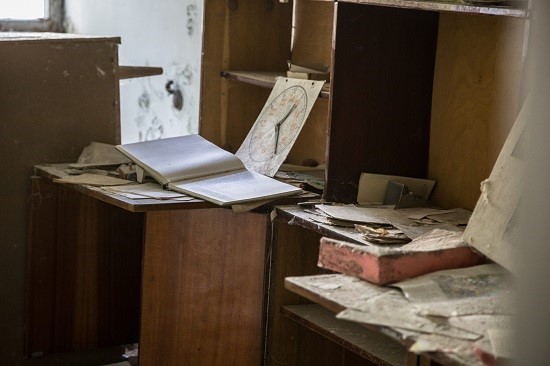Cleaning out a home can be a morbid,
depressing task, often best left until after you are gone, when it is no longer
your problem. But what if you decide to tackle the chore now, while you are
still here to make the decisions?
اضافة اعلان
As we begin to emerge from a long and deadly
pandemic, some older
Americans have decided to do just that.
Professional home organizers are reporting a spike
in calls from older customers asking for help sorting through their belongings,
seeking to dole out the heirlooms and sentimental items, and toss the excess.
The mood, organizers say, is largely upbeat, with people eager to part with
china, furniture, and photographs. In some cases, the inquiries come from grown
children on behalf of their aging parents, keen to get ahead on the task, so
they don’t have to do it alone later.
“There’s been a shift in the consciousness of people
70 and over,” said
Ann Lightfoot, a founder of Done & Done Home, a
New York City home-organizing company that saw its business double in 2021, and an author of
the forthcoming book, “Love Your Home Again.” “They’re like, ‘Oh my God, nobody
wants my stuff. I don’t even want my stuff.’”
Professionals often refer to the task as “death
cleaning,” a term popularized in 2018 with the publication of the book, “The
Gentle Art of Swedish Death Cleaning,” by Margareta Magnusson, which posited
that the prospect of our eventual demise is reason enough to purge.
 (Photo: Envato Elements)
(Photo: Envato Elements)
“Death, that’s a word that scares a lot of people,”
said Magnusson, who is 87, speaking from her home in Stockholm. But in her
view, there’s no reason to avoid the ultimate awkward conversation, because
“that’s the only real thing we know that we will take part of,” she said. “If
we know something about our lives, it’s that we’re going to die, that’s for
sure.”
In that case, we should have the courtesy to not
burden our loved ones with a lifetime of clutter. “I don’t think that’s nice to
leave that to your own children,” said Magnusson, who also suggested tossing
any letters or journals that might offend your children, should they eventually
discover them. Simply put, we should be preparing for the end throughout our
lives, pruning as we go.
Matt Paxton, a
downsizing expert and the host of the PBS show “Legacy List,” also has seen a
marked shift in the mindset of older Americans, who are parting with their
stuff not out of guilt and obligation, but out of an eagerness to get on with
their lives. He pointed to the pandemic as a catalyst for the sudden urge to
downsize. Older Americans, at higher risk for
COVID-19, have been among the
most isolated groups these past couple of years, spending months at home,
largely alone, waiting to get their lives back.
They’re ready to clean out their houses. They’ve been staring at stuff, they’ve been consuming stuff for two years, and they are ready to get rid of everything.
“They’re ready to clean out their houses. They’ve
been staring at stuff, they’ve been consuming stuff for two years, and they are
ready to get rid of everything,” said Paxton, an author of “Keep the Memories,
Lose the Stuff,” which was published this month. “They want to get out of their
house, they want to have experiences, not stuff.”
The pandemic was certainly a catalyst for Ellen
Nenner, who is 85 and goes by Ricki. After spending the past two years alone in
her five-bedroom house in the Queens borough of
New York, she decided to pack
up, sell the house — where she had lived for 50 years — and move to an
apartment on the Upper West Side. “It occurred to me quite soon through the
pandemic that I was really inhabiting a house, that I was not living a life,”
she said. “If I go out to take a walk, it’s a nice neighborhood, but there’s
nothing of interest here.”
The house is in contract with a buyer, so she has
until April to pare down. She has been sorting through photographs and silver
with her daughter, Lisa Nenner Eliseo. The process, she said, evokes memories
of her husband and her younger daughter, who have both died. “Going through the
house has brought us even closer,” Nenner said of her relationship with her
surviving daughter. “We laugh a lot. Sometimes, we cry a lot.”
 (Photo: DEVINE MOVING)
(Photo: DEVINE MOVING)
The process has been overwhelming at times, she
said. But as she has moved along, she has gotten faster. One item was a
gorgeous silver platter, a gift from her mother, that she used at a time in her
life when she hosted dinner parties. But those days are long gone. “As
beautiful as it is, I don’t need it, I have no place for it,” she said. “I can
get along without it.” And so, she will auction the platter, along with the
crystal and Royal Copenhagen dinnerware that her mother gave her. (Her 75
cookbooks, however, will go to a charity.)
Should you look through every photograph? Every
letter? The professionals often advise clients to take their time and be
deliberate, even if it is exhausting.
“At the beginning you’re really gung-ho,” said
Shelley Anbouba, owner of NEAT Method Dallas-Highland Park, in
Texas. “As you
get toward the end, your enthusiasm level changes, and your perspective
changes, and that’s when you say, ‘OK, I’m done, forget it. I’m just going to
get rid of all this.” But Anbouba encourages people to pause in those moments
and avoid making rash decisions.
Lisa Paterson has spent much of the pandemic helping
her 93-year-old mother reorganize her Upper West Side apartment. At first, her
mother was resistant to the idea, showing no interest in combing through her
books, jewelry, and photographs. But Paterson persisted, seeing it as a way to
help her mother be more comfortable in the apartment where she has lived since
1972. “I wanted my mom to live in dignity during this stage of her life,” she
said.
The process has given Paterson, 61, opportunities to
make peace with her childhood and life. Her father died when she was 11, her
brother died at age 27, and her husband was killed in the attack on the World
Trade Center in 2001. Going through photographs and old letters with her mother
has been cathartic. “It’s a nice thing to do with her and prepare yourself for
the end of someone’s life,” she said. “This process has made me feel like I
don’t have any questions unanswered.”
Among all the stuff, Paterson found photographs of
her parents that had been tucked away for decades. She framed one and displayed
it on her mother’s mantel. “I wanted to honor all of her memories,” she said.
Read more Lifestyle




.jpg)
.jpg)



